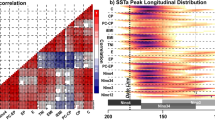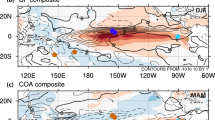Abstract
Recent research on the El Niño–Southern Oscillation (ENSO) phenomenon increasingly reveals the highly complex and diverse nature of ENSO variability. A method of quantifying ENSO spatial pattern uniqueness and diversity is presented, which enables (1) formally distinguishing between unique and “canonical” El Niño events, (2) testing whether historical model simulations aptly capture ENSO diversity by comparing with instrumental observations, (3) projecting future ENSO diversity using future model simulations, (4) understanding the dynamics that give rise to ENSO diversity, and (5) analyzing the associated diversity of ENSO-related atmospheric teleconnection patterns. Here we develop a framework for measuring El Niño spatial SST pattern uniqueness and diversity for a given set of El Niño events using two indices, the El Niño Pattern Uniqueness (EPU) index and El Niño Pattern Diversity (EPD) index, respectively. By applying this framework to instrumental records, we independently confirm a recent regime shift in El Niño pattern diversity with an increase in unique El Niño event sea surface temperature patterns. However, the same regime shift is not observed in historical CMIP5 model simulations; moreover, a comparison between historical and future CMIP5 model scenarios shows no robust change in future ENSO diversity. Finally, we support recent work that asserts a link between the background cooling of the eastern tropical Pacific and changes in ENSO diversity. This robust link between an eastern Pacific cooling mode and ENSO diversity is observed not only in instrumental reconstructions and reanalysis, but also in historical and future CMIP5 model simulations.








Similar content being viewed by others
References
Alexander MA et al (2002) The atmospheric bridge: the influence of ENSO teleconnections on air–sea interaction over the global oceans. J Clim 15.16:2205–2231
An SI, Wang B (2001) Mechanisms of locking of the El Niño and La Niña mature phases to boreal winter. J Clim 14(9):2164–2176
Ashok K, Behera SK, Rao SA, Weng H, Yamagata T (2007) El Niño Modoki and its possible teleconnections. J Geophys Res 112:C11007. https://doi.org/10.1029/2006JC003798
Barlow M, Nigam S, Berbery EH (2001) ENSO, Pacific decadal variability, and US summertime precipitation, drought, and streamflow. J Clim 14:2105–2128
Bjerknes J (1969) Atmospheric teleconnections from the equatorial Pacific. Mon Wea Rev 97:163–172
Cane MA, Eshel G, Buckland RW (1994) Forecasting Zimbabwean maize yield using eastern equatorial Pacific sea surface temperature. Nature 370(6486):204
Cane MA, Clement AC, Kaplan A, Kushnir Y, Pozdnyakov D, Seager R, Murtugudde R (1997) Twentieth-century sea surface temperature trends. Science 275(5302):957–960
Capotondi A, Sardeshmukh PD (2017). Is El Niño really changing? Geophys Res Lett
Capotondi A et al (2015) Understanding ENSO diversity. Bull Am Meteor Soc 96(6):921–938
Carton JA, Giese BS (2008) A reanalysis of ocean climate using simple ocean data assimilation (SODA). Mon Weather Rev 136:2999–3017
Coats S, Karnauskas KB (2017) Are simulated and observed twentieth century tropical pacific sea surface temperature trends significant relative to internal variability? Geophys Res Lett
Dai A, Wigley TML (2000) Global patterns of ENSO-induced precipitation. Geophys Res Lett 27(9):1283–1286
Giese BS, Ray S (2011) El Niño variability in simple ocean data assimilation (SODA), 1871–2008. J Geophys Res Oceans 116.C2
Hirahara S, Ishii M, Fukuda Y (2014) Centennial–scale sea surface temperature analysis and its uncertainty. J Clim 27:57–75
Hong Y, Adler R, Huffman G (2006) Evaluation of the potential of NASA multi-satellite precipitation analysis in global landslide hazard assessment. Geophys Res Lett 33:L22402. https://doi.org/10.1029/2006GL028010
Huang B, Banzon VF, Freeman E, Lawrimore J, Liu W, Peterson TC, Smith TM, Thorne PW, Woodruff SD, Zhang H-M (2014) Extended reconstructed sea surface temperature version 4 (ERSST.v4): Part I. upgrades and intercomparisons. J Clim 28:911–930
Kao H-Y, Yu JY (2009) Contrasting eastern–Pacific and central–Pacific types of ENSO. J Clim 22(3):615–632
Kaplan A, Cane M, Kushnir Y, Clement A, Blumenthal M, Rajagopalan B (1998) Analyses of global sea surface temperature 1856–1991. J Geophys Res 103(589):18567–18589
Karnauskas KB (2013) Can we distinguish canonical El Niño from Modoki? Geophys Res Lett 40(19):5246–5251. https://doi.org/10.1002/grl.51007
Karnauskas KB, Ruiz–Barradas A, Nigam S, Busalacchi AJ (2008) North American droughts in ERA-40 global and NCEP North American regional reanalyses: a Palmer Drought Severity Index perspective. J Clim 21(10):2102–2123. https://doi.org/10.1175/2007JCLI1837.1
Kessler WS (2002) Is ENSO a cycle or a series of events? Geophys Res Lett 29(23):2125. https://doi.org/10.1029/2002GL015924
Kug J-S, Jin F-F, An S-I (2009) Two types of El Niño events: cold tongue El Niño and warm pool El Niño. J Clim, 22, 1499–1515, https://doi.org/10.1175/2008JCLI2624.1
Kug, J‐S, Ham Y-G (2011) Are there two types of La Nina? Geophys Res Lett 38(16)
Kumar K, Krishna et al (2006) Unraveling the mystery of Indian monsoon failure during El Niño. Science 314(5796):115–119
Larkin NK, Harrison DE (2005) On the definition of El Niño and associated seasonal average US weather anomalies. Geophys Res Lett 32:L13705. https://doi.org/10.1029/2005GL022738
Lee T, McPhaden MJ (2010) Increasing intensity of El Niño in the central-equatorial Pacific. Geophys Res Lett 37:14
Li Y et al (2015) Ocean dynamical processes associated with the tropical Pacific cold tongue mode. J Geophys Res Oceans 120(9):6419–6435
Li J et al (2017) Impacts of the tropical Pacific cold tongue mode on ENSO diversity under global warming. J Geophys Res Oceans
McPhaden MJ (2004) Evolution of the 2002/03 El Niño. Bull Am Meteor Soc 85(5):677–695
McPhaden MJ (2015) Playing hide and seek with El Niño. Nat Clim Change 5(9):791
McPhaden MJ, Zebiak SE, Glantz MH (2006) ENSO as an integrating concept in earth science. Science 314(5806):1740–1745
Müller WA, Roeckner E (2008) ENSO teleconnections in projections of future climate in ECHAM5/MPI-OM. Clim Dyn 31(5):533–549
Naylor RL et al (2007) Assessing risks of climate variability and climate change for Indonesian rice agriculture. Proc Natl Acad Sci 104(19):7752–7757
Neelin J, Jin FF, Syu HH (2000) Variations in ENSO phase locking. J Clim 13.14:2570–2590
Polhemus DA (2017) Drought in the US—affiliated Pacific Islands: a multi-level assessment. https://doi.org/10.21429/C9ZS74
Rasmusson EM, Carpenter TH (1982) Variations in tropical sea surface temperature and surface wind fields associated with the Southern Oscillation/El Niño. Mon Weather Rev 110.5:354–384
Ray S, Giese BS (2012) Historical changes in El Niño and La Niña characteristics in an ocean reanalysis. J Geophys Res Oceans 117.C11
Rayner NA, Parker DE, Horton EB, Folland CK, Alexander LV, Rowell DP, Kent EC, Kaplan A (2003) Global analyses of sea surface temperature, sea ice, and night marine air temperature since the late nineteenth century. J Geophys Res 108(D14):4407. https://doi.org/10.1029/2002JD002670
Rojas O, Li Y, Cumani R (2014) Understanding the drought impact of El Niño on the global agricultural areas: an assessment using FAO’s Agricultural Stress Index (ASI). Food and Agriculture Organization of the United Nations
Stevenson SL (2012) Significant changes to ENSO strength and impacts in the twenty-first century: results from CMIP5. Geophys Res Lett 39.17
Takahashi K, Montecinos A, Goubanova K, Dewitte B (2011) ENSO regimes: reinterpreting the canonical and Modoki El Niño. Geophys Res Lett 38:L10704. https://doi.org/10.1029/2011GL047364
Taylor KE, Stouer RJ, Meehl GA (2012) An overview of CMIP5 and the experiment design. Bull Am Meteorol Soc 93:485–498
Trenberth KE (1997) The definition of El Niño. Bull Am Meteor Soc 78(12):2771–2777
Trenberth KE, Guillemot CJ (1996) Physical processes involved in the 1988 drought and 1993 floods in North America. J Clim 9:1288–1298
Trenberth KE, Stepaniak DP (2001) Indices of El Niño evolution. J Clim 14(8):1697–1701
Trenberth KE et al (1998) Progress during TOGA in understanding and modeling global teleconnections associated with tropical sea surface temperatures. J Geophys Res Oceans 103.C7:14291–14324
Tziperman E, Stone L, Cane MA, Jarosh H (1994) El Niño chaos: Overlapping of resonances between the seasonal cycle and the Pacific ocean-atmosphere oscillator. Science-AAAS-Weekly Paper Edition-including Guide to Scientific Information 264(5155):72–73
Wolter K, Timlin MS (1998) Measuring the strength of ENSO events: How does 1997/98 rank? Weather 53(9):315–324
Wu Z et al (2009) An empirical seasonal prediction model of the East Asian summer monsoon using ENSO and NAO. J Geophys Res: Atmos 114(D18). https://doi.org/10.1029/2009JD011733
Yeh S-W, Kug J-S, Dewitte B, Kwon M-H, Kirtman B, Jin F-F (2009) El Niño in a changing climate. Nature. https://doi.org/10.1038/nature08316
Yu BS, Giese (2013) ENSO diversity in observations. US CLIVAR variations, 11, 2, U.S. CLIVAR Program, Washington, DC, pp 1–5
Zhang W, Li J, Zhao X (2010) Sea surface temperature cooling mode in the Pacific cold tongue. J Geophys Res Oceans 115.:C12
Zhang W, Jin FF, Zhao JX, Qi L, Ren HL (2013) The possible influence of a nonconventional El Niño on the severe autumn drought of 2009 in Southwest China. J Clim 26(21):8392–8405
Zhang W, Jin FF, Turner A (2014) Increasing autumn drought over southern China associated with ENSO regime shift. Geophys Res Lett 41(11):4020–4026
Zhang W, Wang L, Xiang B, Qi L, He J (2015) Impacts of two types of La Niña on the NAO during boreal winter. Clim Dyn 44(5–6):1351–1366
Acknowledgements
We acknowledge the WCRP Working Group on Coupled Modelling and U.S. DOE/PCMDI for CMIP, and thank the climate modeling groups for producing and making available their model output (http://cmip-pcmdi.llnl.gov/cmip5/). D.L. acknowledges support from the National Science Foundation Graduate Research Fellowship Program (GRFP). The authors are grateful for helpful conversations with Drs. Antonietta Capotondi, Balaji Rajagopalan and Jeffrey Weiss.
Author information
Authors and Affiliations
Corresponding author
Additional information
This paper is a contribution to the special collection on ENSO Diversity. The special collection aims at improving understanding of the origin, evolution, and impacts of ENSO events that differ in amplitude and spatial patterns, in both observational and modeling contexts, and in the current as well as future climate scenarios. This special collection is coordinated by Antonietta Capotondi, Eric Guilyardi, Ben Kirtman and Sang-Wook Yeh.
Electronic supplementary material
Below is the link to the electronic supplementary material.
Rights and permissions
About this article
Cite this article
Lemmon, D.E., Karnauskas, K.B. A metric for quantifying El Niño pattern diversity with implications for ENSO–mean state interaction. Clim Dyn 52, 7511–7523 (2019). https://doi.org/10.1007/s00382-018-4194-3
Received:
Accepted:
Published:
Issue Date:
DOI: https://doi.org/10.1007/s00382-018-4194-3




